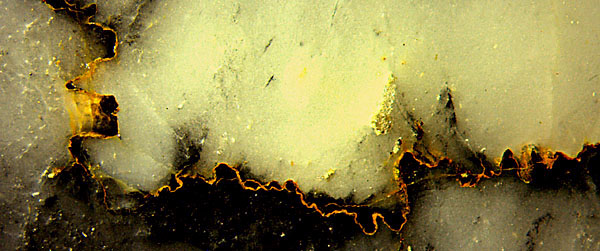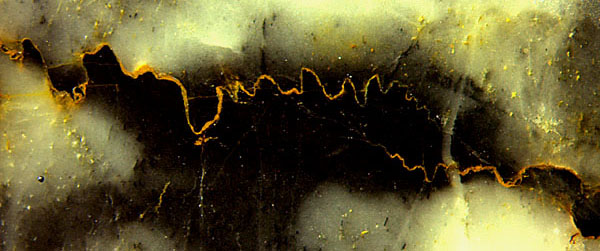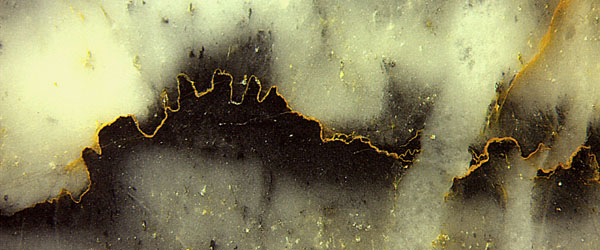Crazy cracks
 Cracks
like these shown here are quite uncommon
and therefore deserve closer consideration. One would hardly believe
that the yellow lines in these pictures
represent cracks on the cut and polished face of a small sample if they
were not really seen as narrow
gaps filled with brittle yellow matter (Figs.1-4).
Cracks
like these shown here are quite uncommon
and therefore deserve closer consideration. One would hardly believe
that the yellow lines in these pictures
represent cracks on the cut and polished face of a small sample if they
were not really seen as narrow
gaps filled with brittle yellow matter (Figs.1-4).
Fig.1: Crack
of enigmatic shape seen as a yellow line. Width of every image 7mm.
Crack
propagation is governed by fracture mechanics. Homogeneous stress in
homogenous materials makes straight cracks. Other crack shapes can
often be explained by locally variable fracture toughness of the
material. The propagating crack tip follows a path of low fracture
toughness. This is conspicuous with some plant
fossils, where the waxy
cuticle on the epidermis
is often poorly silicified so that cracks preferably
follow plant surfaces, as seen in Rhynie
Chert News 1
, 36,
Permian
Chert News 15
. Low fracture toughness of interfaces between
wood cells can make an apparently undulating crack path: Fossil
Wood News 37
 Nothing
of the like applies to the cracks in this sample. A
bleaching process seems to have produced pale
spots and clouds in a dark matrix so that in some places an opposite
aspect of a pale matrix with dark clouds with enigmatic yellow
cracks appears. Some crack fragment may form a distinct boundary
between the clouds which means that the bleaching did not cross the gap.
Nothing
of the like applies to the cracks in this sample. A
bleaching process seems to have produced pale
spots and clouds in a dark matrix so that in some places an opposite
aspect of a pale matrix with dark clouds with enigmatic yellow
cracks appears. Some crack fragment may form a distinct boundary
between the clouds which means that the bleaching did not cross the gap.
Fig.2: Two cracks of erratic
shape in the apparently structureless interior of a dark
cloud.
Another
phenomenon is seen in Fig.3 where two former wide cracks, now filled
with pale substance, had
torn asunder the dark cloud together with the yellow crack inside. The
different types of cracks, narrow and yellow or wide and pale, indicate
that the sample had
undergone a sequence of stages with changing material properties.

Fig.3 (right): Dark cloud with
narrow yellow crack, torn
asunder by two wide pale cracks on the right.
Fig.4
(below): Narrow cracks with enigmatic erratic shapes.

Most
probably the crack shapes do not represent an early pre-existing
structure but are brought about by some kind of spontaneous structure
formation in the course of silicification. Phenomea of this kind can be
highly complex, as may be guessed from Fig.4, where the
extremely erratic crack paths seem to defy any explanation.
|

|
 39 39 |

 39
39 Cracks
like these shown here are quite uncommon
and therefore deserve closer consideration. One would hardly believe
that the yellow lines in these pictures
represent cracks on the cut and polished face of a small sample if they
were not really seen as narrow
gaps filled with brittle yellow matter (Figs.1-4).
Cracks
like these shown here are quite uncommon
and therefore deserve closer consideration. One would hardly believe
that the yellow lines in these pictures
represent cracks on the cut and polished face of a small sample if they
were not really seen as narrow
gaps filled with brittle yellow matter (Figs.1-4). Nothing
of the like applies to the cracks in this sample. A
bleaching process seems to have produced pale
spots and clouds in a dark matrix so that in some places an opposite
aspect of a pale matrix with dark clouds with enigmatic yellow
cracks appears. Some crack fragment may form a distinct boundary
between the clouds which means that the bleaching did not cross the gap.
Nothing
of the like applies to the cracks in this sample. A
bleaching process seems to have produced pale
spots and clouds in a dark matrix so that in some places an opposite
aspect of a pale matrix with dark clouds with enigmatic yellow
cracks appears. Some crack fragment may form a distinct boundary
between the clouds which means that the bleaching did not cross the gap.


 39
39